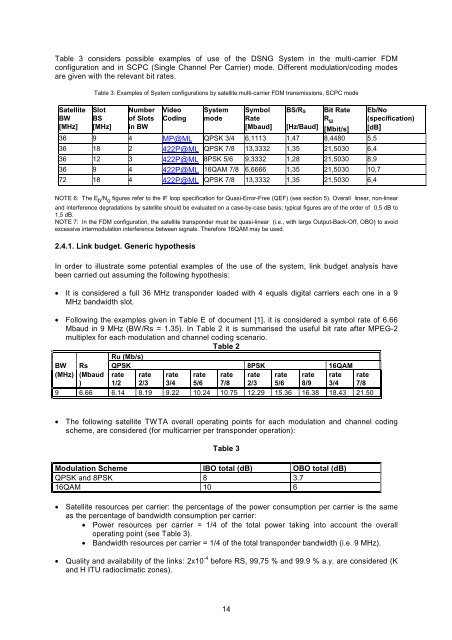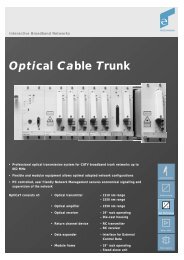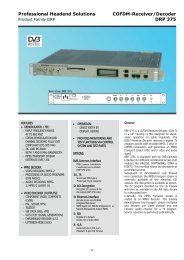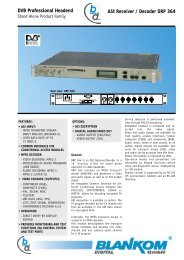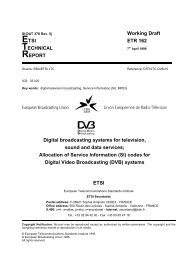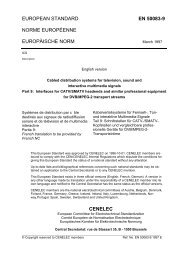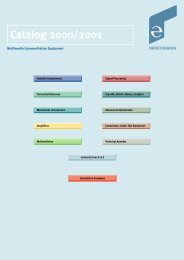Digital Video Broadcasting (DVB); User guidelines for Digital ...
Digital Video Broadcasting (DVB); User guidelines for Digital ...
Digital Video Broadcasting (DVB); User guidelines for Digital ...
You also want an ePaper? Increase the reach of your titles
YUMPU automatically turns print PDFs into web optimized ePapers that Google loves.
Table 3 considers possible examples of use of the DSNG System in the multi-carrier FDM<br />
configuration and in SCPC (Single Channel Per Carrier) mode. Different modulation/coding modes<br />
are given with the relevant bit rates.<br />
Satellite<br />
BW<br />
[MHz]<br />
Table 3: Examples of System configurations by satellite:multi-carrier FDM transmissions, SCPC mode<br />
Slot<br />
BS<br />
[MHz]<br />
Number<br />
of Slots<br />
in BW<br />
<strong>Video</strong><br />
Coding<br />
System<br />
mode<br />
14<br />
Symbol<br />
Rate<br />
[Mbaud]<br />
BS/RS<br />
[Hz/Baud]<br />
Bit Rate<br />
Ru [Mbit/s]<br />
36 9 4 MP@ML QPSK 3/4 6,1113 1,47 8,4480 5,5<br />
36 18 2 422P@ML QPSK 7/8 13,3332 1,35 21,5030 6,4<br />
36 12 3 422P@ML 8PSK 5/6 9,3332 1,28 21,5030 8,9<br />
36 9 4 422P@ML 16QAM 7/8 6,6666 1,35 21,5030 10,7<br />
72 18 4 422P@ML QPSK 7/8 13,3332 1,35 21,5030 6,4<br />
Eb/No<br />
(specification)<br />
[dB]<br />
NOTE 6: The E b /N o figures refer to the IF loop specification <strong>for</strong> Quasi-Error-Free (QEF) (see section 5). Overall linear, non-linear<br />
and interference degradations by satellite should be evaluated on a case-by-case basis; typical figures are of the order of 0,5 dB to<br />
1,5 dB.<br />
NOTE 7: In the FDM configuration, the satellite transponder must be quasi-linear (i.e., with large Output-Back-Off, OBO) to avoid<br />
excessive intermodulation interference between signals. There<strong>for</strong>e 16QAM may be used.<br />
2.4.1. Link budget. Generic hypothesis<br />
In order to illustrate some potential examples of the use of the system, link budget analysis have<br />
been carried out assuming the following hypothesis:<br />
• It is considered a full 36 MHz transponder loaded with 4 equals digital carriers each one in a 9<br />
MHz bandwidth slot.<br />
• Following the examples given in Table E of document [1], it is considered a symbol rate of 6.66<br />
Mbaud in 9 MHz (BW/Rs = 1.35). In Table 2 it is summarised the useful bit rate after MPEG-2<br />
multiplex <strong>for</strong> each modulation and channel coding scenario.<br />
Table 2<br />
Ru (Mb/s)<br />
BW Rs QPSK 8PSK 16QAM<br />
(MHz) (Mbaud rate rate rate rate rate rate rate rate rate rate<br />
) 1/2 2/3 3/4 5/6 7/8 2/3 5/6 8/9 3/4 7/8<br />
9 6.66 6.14 8.19 9.22 10.24 10.75 12.29 15.36 16.38 18.43 21.50<br />
• The following satellite TWTA overall operating points <strong>for</strong> each modulation and channel coding<br />
scheme, are considered (<strong>for</strong> multicarrier per transponder operation):<br />
Table 3<br />
Modulation Scheme IBO total (dB) OBO total (dB)<br />
QPSK and 8PSK 8 3.7<br />
16QAM 10 6<br />
• Satellite resources per carrier: the percentage of the power consumption per carrier is the same<br />
as the percentage of bandwidth consumption per carrier:<br />
• Power resources per carrier = 1/4 of the total power taking into account the overall<br />
operating point (see Table 3).<br />
• Bandwidth resources per carrier = 1/4 of the total transponder bandwidth (i.e. 9 MHz).<br />
• Quality and availability of the links: 2x10 -4 be<strong>for</strong>e RS, 99,75 % and 99.9 % a.y. are considered (K<br />
and H ITU radioclimatic zones).


